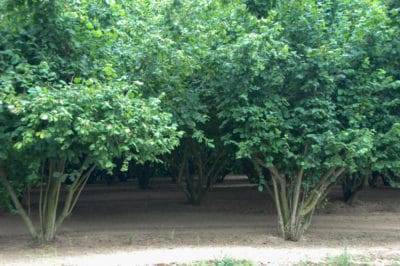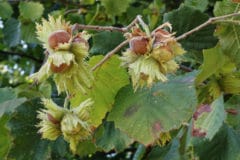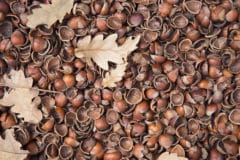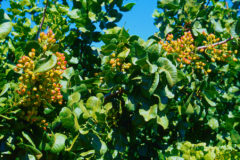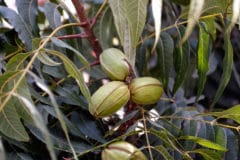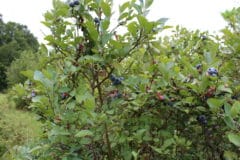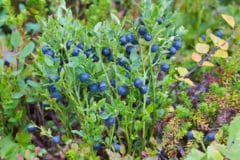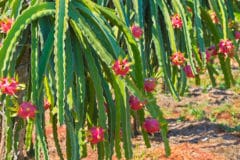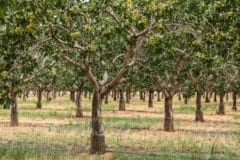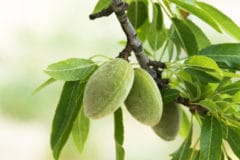Expert gardener’s tips:
- For a variety of reasons, hazelnuts are also known as filberts or cobnuts.
- The exception to the bush or small tree rule is the Turkish hazel tree (Corylus corluna). Suitable for USDA zones 4 through 7, it reaches 40 to 50 feet tall with a 15- to 35-foot spread.
Commercial Hazelnuts
From a commercial standpoint, three species of hazelnuts are important:
- Beaked and American hazelnuts (Corylus cornuta, Corylus americana) are valued for their cold tolerance and resistance to the devastating eastern filbert blight disease (EFB). They grow in USDA plant hardiness zones 3 through 8 and 9, respectively.
- European or common hazelnuts (Corylus avellana) are native to Europe and western Asia. They produce the large, rich nuts found in gourmet chocolate, coffee and baked goods their American relatives, but are hardy only to USDA zone 4 and highly susceptible to EFB.
All three of these hazelnuts grow as vase-shaped, multi-stemmed shrubs. They reach from 10 to 16 feet tall and up to 13 feet wide. With regular pruning, however, they stay much smaller. European hazelnuts are often trained as small trees.
Hybrid Hazelnuts
In the 1970s, researchers found that European hazelnut cultivar ‘Gasaway’ was resistant to EFB. After nearly 50 years of backcrossing other varieties to ‘Gasaway,’ breeders began commercializing several EFB-resistant hybrids. Among them are:
- ‘Yamhill’
- ‘Jefferson’
- ‘Dorris’
- ‘Epsilon’
- ‘Felix’
- ‘Gamma’
All these hybrids grow as trees 8 to 12 feet tall, with an up to 12-foot spread. Others may top out at 15 to 20 feet. Depending on their variety, hazelnut hybrids are hardy in USDA zones 4 through 8 or 9.
Ornamental Features
Cascades of yellow male flowers dangle like long, slender pine cones from hazelnut branches in spring. They far outshine the inconspicuous females nestled on the branch tips. In fall, the plants’ nutshells deepen from green to hazel and their deep-green leaves become tinged with shades of yellow, orange, rose or purple.
’Red Dragon’ Hazelnut
If you’re willing to exchange a bountiful nut harvest for a four-season showstopper, grow a ‘Red Dragon’ (Corylus avellana ‘Red Dragon’)tree. It pairs sinuously twisted branches with burgundy-red spring flowers. Its new branches and leaves emerge dark red and its red nut husks contrast strikingly with bronze summer leaves.
Its one drawback is that its only pollinator is the EFB-susceptible European hazelnut – and even when pollinated, its yield is small. ‘Red Dragon’ is hardy in USDA zones 4 through 9.
Where Hazelnuts Grow Best
The good news is that hazelnuts produce the most nuts in relatively low-nutrient soil. Growing them on a very fertile site results in lots of foliage but very few flowers or nuts. They need good drainage and four or more hours of daily sun. More is better.
Hazelnuts and Pollination
Although hazelnuts produce both male and female flowers, they rarely self pollinate. To guarantee yourself a harvest, it’s essential to plant in groups of three or more. By doing so, you’ll multiply the odds that some flowers are shedding pollen while others are receptive to receiving it.
The best way to accomplish that is to plant several varieties that produce pollen at different times. Compatible groups with early-, mid-and late-spring pollinators include:
- ‘Jefferson’ with ‘Felix,’ ‘Theta’ and ‘Eta’
- ‘Yamhill’ with ‘Gamma,’ ‘Jefferson’ and/or ‘Epsilon’
Expert gardener’s tip: Some hazelnut varieties carry a genetic quirk that limits the number of other cultivars they can receive pollen from. It’s essential to do your homework before choosing your groupings. Otherwise, you’ll have healthy, attractive bushes but no harvests.
Pruning Hazelnut Bushes
To keep hazelnut bushes trim and tidy, prune in winter by cutting about one-third of the oldest branches back to the soil. Open up the center for better sun exposure and air circulation, but leave the youngest twigs where the female flowers grow.
Always remove suckers — the stems that emerge along the roots — as soon as they appear. Unless you dig them up, your hazelnut’s growth will soon be out of control.
